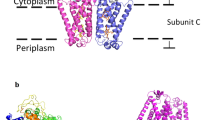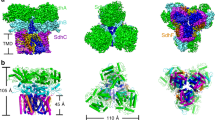Abstract
Succinate:menaquinone oxidoreductase from Corynebacterium glutamicum, a high-G+C, Gram-positive bacterium, was purified to homogeneity. The enzyme contained two heme B molecules and three polypeptides with apparent molecular masses of 67, 29 and 23 kDa, which corresponded to SdhA (flavoprotein), SdhB (iron–sulfur protein), and SdhC (membrane anchor protein), respectively. In non-denaturating polyacrylamide gel electrophoresis, the enzyme migrated as a single band with an apparent molecular mass of 410 kDa, suggesting that it existed as a trimer. The succinate dehydrogenase activity assayed using 2,3-dimethoxy-5-methyl-6-decyl-1,4-benzoquinone and 2,6-dichloroindophenol as the electron acceptor was inhibited by 2-n-heptyl-4-hydroxyquinoline N-oxide (HQNO), and the Dixon plots were biphasic. In contrast, the succinate dehydrogenase activity assayed using phenazine methosulfate and 2,6-dichloroindophenol was inhibited by p-benzoquinone and not by HQNO. These findings suggested that the C. glutamicum succinate:menaquinone oxidoreductase had two quinone binding sites. In the phylogenetic tree of SdhA, Corynebacterium species do not belong to the high-G+C group, which includes Mycobacterium tuberculosis and Streptomyces coelicolor, but are rather close to the group of low-G+C, Gram-positive bacteria such as Bacillus subtilis. This situation may have arisen due to the horizontal gene transfer.






Similar content being viewed by others
References
Chance B (1957) Techniques for the assay of the respiratory enzymes. Methods Enzymol 4:273–329
Collins MD, Pirouz T, Goodfellow M, Minnikin DE (1977) Distribution of menaquinones in actinomycetes and corynebacteria. J Gen Microbiol 100:221–230
Hägerhäll C (1997) Succinate:quinone oxidoreductases. Variations on a conserved theme. Biochim Biophys Acta 1320:107–141
Hägerhäll C, Hederstedt L (1996) A structural model for the membrane-integral domain of succinate:quinone oxidoreductases. FEBS Lett 389:25–31
Hägerhäll C, Aasa R, von Wachenfeldt C, Hederstedt L (1992) Two hemes in Bacillus subtilis succinate:menaquinone oxidoreductase. Biochemistry 31:7411–7421
Hägerhäll C, Fridén H, Aasa R, Hederstedt L (1995) Transmembrane topology and axial ligands to hemes in cytochrome b558 subunit of Bacillus subtilis succinate:menaquinone reductase. Biochemistry 34:11080–11089
Hederstedt L (2002) Succinate:quinone oxidoreductase in the bacteria Paracoccus denitrificans and Bacillus subtilis. Biochim Biophys Acta 1553:74–83
Ikeuchi M, Inoue Y (1988) A new photosystem II reaction center component (4.8 kDa protein) encoded by chloroplast genome. FEBS Lett 241:99–104
Iverson TM, Luna-Chavez C, Cecchini G, Rees DC (1999) Structure of the Escherichia coli FRD respiratory complex. Science 284:1961–1966
Kalinowski J, Bathe B, Bartels D, Bischoff N, Bott M, Burkovski A, Dusch N, Eggeling L, Eikmanns BJ, Gaigalat L, Goesmann A, Hartmann M, Huthmacher K, Kramer R, Linke B, McHardy AC, Meyer F, Mockel B, Pfefferle W, Puhler A, Rey DA, Ruckert C, Rupp O, Sahm H, Wendisch VF, Wiegrabe I, Tauch A (2003) The complete Corynebacterium glutamicum ATCC 13032 genome sequence and its impact on the production of L-aspartate-derived amino acids and vitamins. J Biotechnol 104:5–25
Kusumoto K, Sakiyama M, Sakamoto J, Noguchi S, Sone N (2000) Menaquinol oxidase activity and primary structure of cytochrome bd from the amino-acid fermenting bacterium Corynebacterium glutamicum. Arch Microbiol 173:390–397
Laemmli UK (1970) Cleavage of structural proteins during the assembly of the head of bacteriophage T4. Nature 227:680–685
Lancaster CR, Kröger A (2000) Succinate:quinone oxidoreductases: new insights from X-ray crystal structures. Biochim Biophys Acta 1459:422–431
Lancaster CR, Kröger A, Auer M, Michel H (1999) Structure of FRD from Wolinella succinogenes at 2.2 Å resolution. Nature 402:377–385
Lemma E, Unden G, Kröger A (1990) Menaquinone is an obligatory component of the chain catalyzing succinate respiration in Bacillus subtilis. Arch Microbiol 155:62–67
Lemma E, Hägerhäll C, Geisler V, Brandt U, von Jagow G, Kröger A (1991) Reactivity of the Bacillus subtilis succinate dehydrogenase complex with quinones. Biochim Biophys Acta 1059:281–285
Lemos RS, Fernandes AS, Pereira MM, Gomes CM, Teixeira M (2002) Quinol:fumarate oxidoreductases and succinate:quinone oxidoreductases: phylogenetic relationships, metal centres and membrane attachment. Biochim Biophys Acta 1553:158–170
Lowry OH, Rosebrough NJ, Farr AL, Randall RJ (1951) Protein measurement with the Folin phenol reagent. J Biol Chem 193:265–275
Matsson M, Tolstoy D, Aasa R, Hederstedt L (2000) The distal heme center in Bacillus subtilis succinate:quinone reductase is crucial for electron transfer to menaquinone. Biochemistry 39:8617–8624
Niebisch A, Bott M (2001) Molecular analysis of the cytochrome bc1– aa3 branch of the Corynebacterium glutamicum respiratory chain containing an unusual diheme cytochrome c1. Arch Microbiol 175:282–294
Oyedotun KS, Lemire BD (1999) The Saccharomyces cerevisiae succinate-ubiquinone oxidoreductase. Identification of Sdh3p amino acid residues involved in ubiquinone binding. J Biol Chem 274:23956–23962
Oyedotun KS, Lemire BD (2001) The quinone-binding sites of the Saccharomyces cerevisiae succinate-ubiquinone oxidoreductase. J Biol Chem 276:16936–16943
Pappenheimer AM Jr, Hendee E (1949) Diphtheria toxin. V. A comparison between the diphtherial succinoxidase system and that of beef heart muscle. J Biol Chem 180:597–609
Pereira MM, Teixeira M (2003) Is a Q-cycle-like mechanism operative in dihaemic succinate:quinone and quinol:fumarate oxidoreductases? FEBS Lett 543:1–4
Sakamoto J, Koga E, Mizuta T, Sato C, Noguchi S, Sone N (1999) Gene structure and quinol oxidase activity of a cytochrome bd-type oxidase from Bacillus stearothermophilus. Biochim Biophys Acta 1411:147–158
Sakamoto J, Shibata T, Mine T, Miyahara R, Torigoe T, Noguchi S, Matsushita K, Sone N (2001) Cytochrome c oxidase contains an extra charged amino acid cluster in a new type of respiratory chain in the amino-acid-producing Gram-positive bacterium Corynebacterium glutamicum. Microbiology 147:2865–2871
Sato-Watanabe M, Mogi T, Miyoshi H, Iwamura H, Matsushita K, Adachi O, Anraku Y (1994) Structure-function studies on the ubiquinol oxidation site of the cytochrome bo complex from Escherichia coli using p-benzoquinones and substituted phenols. J Biol Chem 269:28899–28907
Schäfer G, Anemuller S, Moll R (2002) Archaeal complex II: “classical” and “non-classical” succinate:quinone reductases with unusual features. Biochim Biophys Acta 155:57–73
Schägger H, Cramer WA, von Jagow G (1994) Analysis of molecular masses and oligomeric states of protein complexes by blue native electrophoresis and isolation of membrane protein complexes by two-dimensional native electrophoresis. Anal Biochem 217:220–230
Schirawski J, Unden G (1998) Menaquinone-dependent succinate dehydrogenase of bacteria catalyzes reversed electron transport driven by the proton potential. Eur J Biochem 257:210–215
Schnorpfeil M, Janausch IG, Biel S, Kröger A, Unden G (2001) Generation of a proton potential by succinate dehydrogenase of Bacillus subtilis functioning as a fumarate reductase. Eur J Biochem 268:3069–3074
Smirnova IA, Hägerhäll C, Konstantinov AA, Hederstedt L (1995) HOQNO interaction with cytochrome b in succinate: menaquinone oxidoreductase from Bacillus subtilis. FEBS Lett 359:23–26
Sone N, Nagata K, Kojima H, Tajima J, Kodera Y, Kanamaru T, Noguchi S, Sakamoto J (2001) A novel hydrophobic diheme c-type cytochrome. Purification from Corynebacterium glutamicum and analysis of the QcrCBA operon encoding three subunit proteins of a putative cytochrome reductase complex. Biochim Biophys Acta 1503:279–290
Steyn-Parve ET, Beinert (1958) On the mechanism of dehydrogenation of fatty acyl derivatives of coenzyme A. VI. Isolation and properties of stable enzyme-substrate complexes. J Biol Chem 233:843–852
Thompson JD, Higgins DG, Gibson TJ (1994) CLUSTAL W: improving the sensitivity of progressive multiple sequence alignment through sequence weighting, positions-specific gap penalties and weight matrix choice. Nucleic Acids Res 22:4674–4680
Towbin H, Staehelin T, Gordon J (1979) Electrophoretic transfer of proteins from polyacrylamide gels to nitrocellulose sheets: procedure and some applications. Proc Natl Acad Sci USA 76:4350–4354
Woese CR (1987) Bacterial ecolution. Microbiol Rev 51:221–271
Yankovskaya V, Horsefield R, Tornroth S, Luna-Chavez C, Miyoshi H, Leger C, Byrne B, Cecchini G, Iwata S (2003) Architecture of succinate dehydrogenase and reactive oxygen species generation. Science 299:700–704
Author information
Authors and Affiliations
Corresponding author
Rights and permissions
About this article
Cite this article
Kurokawa, T., Sakamoto, J. Purification and characterization of succinate:menaquinone oxidoreductase from Corynebacterium glutamicum. Arch Microbiol 183, 317–324 (2005). https://doi.org/10.1007/s00203-005-0775-8
Received:
Revised:
Accepted:
Published:
Issue Date:
DOI: https://doi.org/10.1007/s00203-005-0775-8




